As we saw with the 2019 winter wheat crop, if winter wheat is planted late and if conditions are not fit, there is a greater risk of winter survival issues. When it comes to determining your optimum planting date for your region, Ontario’s Optimum Winter Wheat Planting Date map (Figure 1) is a great resource. When determining the optimum date, find your location on the map and look at the dates on the lines on either side of you. The planting date range for that region falls between those two dates. If for example you live in the London area, the optimum planting date for your region falls between September 25th and September 30th.

Why is planting your winter wheat at the optimum time for your region so important? Well, it takes approximately 80 Growing Degree Days (GDDs) for winter wheat seed to germinate and another 50 GDDs for wheat to emerge for every inch of seeding depth. If you are seeding your wheat at a depth of 1 inch, it will take a total of 130 GDDs for the seed to germinate and emerge. If you plant deeper, it will take more GDDs for those plants to emerge. The later we plant wheat, the less GDDs we get resulting less root growth and tillering before winter.
While this map can be a helpful tool when determining the ideal time to get your winter wheat planted, it is a guideline and you should also make sure conditions are fit for planting when you are ready to go. If the conditions aren’t right and waiting a day or two beyond the optimum date means better planting conditions, then wait for the better planting conditions.
While it may come as a surprise, you can acrtually plant winter wheat too early due to the increased risk of snow mould, lodging and Barley Yellow Dwarf Virus (BYDV). It is generally not recommended to seed more than 10-14 days prior to the optimum date for your region. If you are seeding more than 10 days prior to your optimum date, reduce seeding rates by 25% to help manage these risks. If you are planting later than the optimum date, the seeding rate should be increased by 200,000 seeds/acre per week to a maximum of 2.2 million seeds/acre to compensate for the delayed planting.
Seeding depth and the use of a starter fertilizer are also significant factors that need special attention at planting. Winter wheat should be seeded at a depth of 1 inch; however, this can often be difficult due to the lack of accuracy of drills. Therefore, you should target 1.25-1.5 inches to ensure you are seeding your wheat deep enough. Shallow seeding can result in plants being more prone to winterkill and heaving.
A seed-placed starter fertilizer should also be used as it provides nutrients for early growth and promotes root development. As a result, we see an improvement in winter survival and crop uniformity which helps with disease management the following spring.
Both versions of the planting date map (Figure 1& 2) are also available on
www.GoCereals.ca. The maps can be found under the downloads section of the “Resources” page.